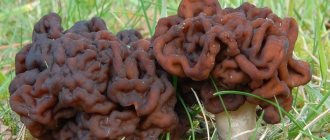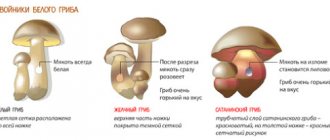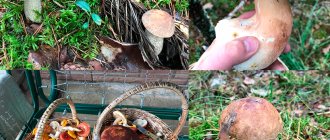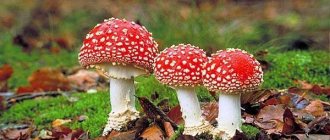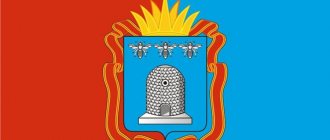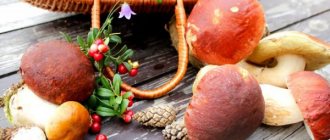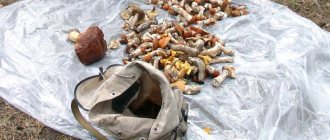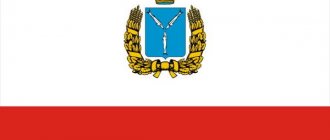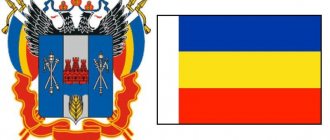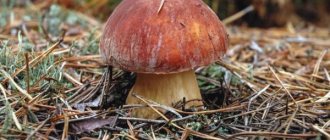The territory of the Kharkov region is located in the north-east of Ukraine, and it is here that lovers of quiet hunting most often actively collect edible mushrooms, which is due to high-yielding chernozem soils and favorable climatic conditions.
Novice mushroom pickers are very often interested in the questions: when, where and what are the most valuable edible and dangerous or inedible mushrooms that grow in this forest-rich area, so the article will be devoted to the timing and characteristics of collection, as well as a description of the main, most common types of mushrooms.
Spring and summer edible mushrooms
The Kharkov region is located on the border of the junction of the forest-steppe landscape zone in the north with the steppe southern zone . That is why in the forests of the Kharkov region it is difficult to separate spring mushrooms from summer species. In favorable weather conditions, purely summer species appear in May, thereby opening the main mushroom season for lovers of “quiet hunting”.
| Name | hat | Leg | Pulp | |||
| coloring | form | coloring | form | coloring | density | |
| Aspen | Red, orangeish or brownish red | Hemispherical, or cushion-convex | White or brown | Solid, with extension at the bottom | White, blue | Meaty and dense |
| Berezovik | White to dark brown | Convex or flattened | White | Slightly thickened below | White | Relatively dense |
| Chanterelle | Light yellow to orangish yellow | With wavy edges or irregular shape | Yellow-orange | Solid, dense and smooth | Yellow | Dense fleshy |
| Oiler | Various shades of yellow-gray-brown | From convex to flat | Various shades of yellow-gray-brown | Solid, smooth or grainy | Whitish or yellowish | Relatively dense consistency |
| Champignon | White to brownish brown | First round, then flat | Whitish-grayish color | Central, smooth and dense | Different shades of white | Medium density |
| Porcini | Olive brown or brown | Convex | Whitish | Club-shaped | White | Very dense |
| Polish mushroom | Dark brown or brownish | Semicircular, convex or almost flat | Light brown | Slightly narrowed or widened | White or yellowish, bluish | Meaty and relatively dense |
Names and photos of edible varieties of mushrooms
Edible varieties include mushrooms that are collected from the forest or artificially cultivated for later use in cooking. Most of them have a pleasant specific taste, and some are even considered delicacies. Edible types are nutritious, rich in vitamins, and promote rapid absorption of food. These include:
- White mushrooms;
- boletus;
- saffron milk caps;
- Russula;
- Champignon;
- boletus;
- Shiitake mushrooms.
Before picking mushrooms, it is not enough to know their names and edible species; it is important to carefully study their photos and descriptions, which will eliminate mistakes in the forest.
White mushrooms
These mushrooms belong to the Borovikov genus. They are easy to distinguish by the following characteristic features: a wide (on average 15-30 cm in diameter) cap and a thick, barrel-shaped stem. The cap is characterized by a smooth outer surface and the presence of mucus in wet weather.
Its color can vary from yellow to purple. The leg can reach 25 cm in diameter. Its color in young organisms can vary from white to red-brownish. On the surface of the upper part of the leg there is a network of light veins.
The pulp is strong and fleshy, with a slight odor when raw. The flesh of young organisms is white, while that of older ones is yellowish. Does not change color when cut or broken. The white or yellowish hymenophore is easily separated from the cap. The pores are small and round. The spore print is olive-brown. The spores are spindle-shaped and most often reach a size of 15.5 × 5.5 µm.
You may be interested in:
Poisonous mushrooms similar to honey mushrooms: differences and differences (27 photos) One of the most common mushrooms in the middle climate zone is honey mushrooms. They are edible and...Read more...
Porcini mushrooms “live” in mixed forests, most often choosing places with a lot of mosses and lichens. Each species has its own habitat. Thus, birch mushroom can be found in birch forests and on their edges, pine mushroom - in forests, spruce mushroom - in fir forests. The optimal collection time is from late June to early October.
Boletus
Boletaceae are a genus of the Boletaceae family. The boletus consists of a massive stem and a large rounded cap. The latter is velvety to the touch, dry and smooth, reaches 25 cm in diameter. The size of the leg depends on the subspecies - the average is 3-18 cm. The leg is massive and has a fibrous surface. Most often colored yellowish or brown.
The pulp of boletus mushrooms is light lemon, turning blue or red at the point of cutting. The hymenophore is olive or light yellow, the spores are rounded. The color of spore powder has a wide color range.
Hogs are widespread in coniferous and deciduous forests with temperate climates. They can grow in groups or singly. Often found under trees such as pine, spruce, oak and hornbeam.
Saffron milk caps
Saffron milk caps belong to the Milky genus. They are used in cooking and are valued for their high taste; some types are considered a delicacy. The name reflects the external characteristics: the color of the fruiting body is most often orange, reddish or yellow. The color is acquired with the help of beta-carotene, which is then transformed into vitamin A.
Good to know!
Saffron milk caps are considered a very healthy product: they contain fiber, phosphorus, ascorbic acid and vitamin B. They are eaten even when on a diet.
Saffron milk caps are found in mixed forests and are easy to find even under a layer of pine needles. The average diameter of the round-shaped cap is 7-18 cm. Its surface is slippery, and especially sticky during the rainy season. Young saffron milk caps have a convex cap, but over time it changes shape: the edges rise, forming a funnel in the middle of the cap.
The leg is hollow, its height does not exceed 10 cm. The pulp is dense and light, has a pungent taste and a sweetish smell due to the presence of milky juice. The tubular layer is lamellar, extends slightly onto the surface of the stem and is difficult to separate from it.
Saffron milk caps are widespread in pine and spruce forests, often growing under a layer of fallen pine needles. They are rarely found in dry weather and appear in greater numbers during the rainy season. The beginning of the collection of saffron milk caps is July, the richest harvest can be collected in August.
Russula
These mushrooms belong to the Russula family. Most species are edible, although some may have a bitter taste. They are not consumed raw due to their ability to irritate mucous membranes. The caps of russula are spherical, but gradually become flat or take the shape of funnels. The edges of the cap may be striped and ribbed. The cap is covered with dry matte skin and is easily separated from the pulp.
The shape of the russula plates differs among different species. They may have unequal length, blunt or pointed edges. A common feature of the plates in all species is fragility and color, varying from yellow to ocher.
Russula stems are smooth, cylindrical in shape, and rarely thickened at the base. Depending on the type, they can be hollow or dense. The average size is 4-7 cm. The pulp is both fragile and spongy, and does not change color when a cut appears on it. Spore powder is white.
Green russula
Russulas grow in temperate climates, next to many trees: pine, linden, aspen, birch. They can be found in groups on sandy and wet soils. Russulas appear in the spring, but the collection season is in August and September.
Champignon
Champignons belong to the Agariaceae family and are cultivated throughout the world. They are of great economic importance and are widely used in cooking. Champignons contain essential amino acids, including cysteine and methionine. Antibiotics are made from some species.
The size of champignons varies greatly depending on the type - from 5 to 25 cm. The cap is dense, has a smooth surface, can be snow-white or brownish, with dark scales. The plates are very dark, which makes it possible to distinguish the champignon from poisonous varieties, the plates of which do not darken.
You may be interested in:
Marinated champignons in 20 minutes Marinated champignons are necessary for preparing many holiday salads and more. They are also crazy...Read more...
The leg is small and smooth, the flesh is light, turning yellow when broken and in contact with air. Her scent is pronounced. The champignons have a private covering that leaves a mark on the stem.
Champignons can be found in the steppes, meadows and open glades. They grow mainly on fertile and humus-rich soil, and can be found on dead tree bark. Champignons can be collected from the beginning of May until the end of summer.
Shiitake
Shiitake is a mushroom widely found and often used in culinary and medicinal practices in China and Japan. It has a hemisphere-shaped cap, the diameter of which does not exceed 20 cm. The surface of the cap is dry and velvety to the touch, has a coffee tint and often cracked skin.
The plates are very thin and white, darkening when pressed on them. The leg is straight, its average length is 15 cm. It is painted beige or light brown and has a noticeable fringe. The pulp is fleshy and dense, has a strong spicy aroma. The spores are elliptical in shape and white in color.
Shiitake is most often sold dried, after which it is soaked and used for cooking. The beneficial properties of Shiitake are manifested in the prevention of respiratory diseases and help improve blood circulation.
Butter
Butterflies are tubular edible mushrooms that got their name because of the slippery surface of the cap. A characteristic feature is the sticky skin, which is easily removed from the cap. The latter can have a convex or flat shape. The legs are smooth and sometimes have remnants of a private covering.
You may be interested in:We marinate boletus - which recipe is the most delicious? Boletus is distinguished by its sticky and moist brown cap, on which forest debris is firmly attached.... Read more...
The pulp is light in color and changes color to blue or red when cut. The spore powder has a yellow tint. Butterworts are common in coniferous forests and grow in temperate climates.
Edible mushrooms: varieties (video)
| Name | hat | Leg | Pulp | |||
| coloring | form | coloring | form | coloring | density | |
| Borovik | Maroon | Cushion-shaped or round | Yellow-gray | With thickening at the base or in the middle part | White | Relatively dense, fibrous |
| Mosswort | Beige-brown or dark brown | Convex or cushion-shaped | Brown-brown | Straight or with extension | Whitish, yellowish or reddish | Medium density |
| Honey fungus | Honey yellow | Convex or flat | Slightly lighter than the cap | Tall and smooth | Yellow-brown | Thin and watery |
| Ryzhik | Yellowish-ocher or dark orange | Convex or funnel-shaped | Slightly lighter than the cap | Smooth, narrowing at the base | Yellowish-orange, greenish | Quite dense |
| Kozlyak, or reshetnik | Reddish-brown, with a red tint | Convex, cushion-shaped, plano-convex, flat | Lighter than a hat | Solid, curved or tapered | Pale yellow, turning pink | Dense and elastic |
| Greenfinch | Greenish-yellow or yellow-olive | Plano-convex or flattened | Yellow or yellowish-green | Slightly thickened at the bottom | White or yellowish | Sufficient density |
| Belyanka | White with a yellowish tint | Convex, prostrate to funnel-shaped | Same color as the hat | Tapers towards the base | White | Dense but brittle |
Inedible and dangerous species
Unlike poisonous mushrooms, inedible species do not have any external or taste qualities that make them impossible to eat. The fruiting bodies of inedible species are not capable of causing significant harm to the human body, but the use of poisonous specimens for food purposes, on the contrary, often causes severe poisoning and death. The most common poisonous species include some types of fly agaric and the very dangerous pale grebe. There are several more inedible mushrooms, but the following five species are of greatest interest.
| Name | hat | Leg | Pulp | |||
| coloring | form | coloring | form | color | density | |
| False chanterelle | Orange with a copper tint | Round, with relatively smooth edges | Orange with a copper tint | With a slight narrowing at the base | Orange with a copper tint | Relatively dense |
| Bile mushroom | Brownish or olive brown | Semicircular or cushion-prostrate | Tan | Tuberous or relatively straight | White, turns pink at the break | Medium density |
| Fat pig | Dark brown | Leukoid or tongue-shaped | Black-brown | Lateral or central, thickened at the base | Whitish, darkening at the break | Dense, quite meaty |
| Sarcoscipha cinnabar red | Quite bright red color | Cup-shaped or funnel-shaped, with jagged edges | Reddish | Short, tapering at the base | Reddish | Thin and fragile, waxy type |
| Pepper oiler | Brown with a yellow tint | Flat or convex | Yellow-brown | Tapered at the base | Yellowish, reddening | Relatively dense |
Mushroom spots in the area
Boletus and Polish mushrooms are especially highly valued. Well known to connoisseurs of “quiet hunting,” boletus mushrooms are mycorrhiza-formers with coniferous and deciduous trees and are widespread in the temperate climate zone. The Polish mushroom most often forms mycorrhiza with pine, spruce, beech, oak and European chestnut plantings.
But the inedible cinnabar-red Sarcoscypha grows in entire groups in Ukraine in early spring and is located on dead wood of deciduous trees. The dangerous pallid grebe can be green, yellow or white . In the Kharkov region, these poisonous mushrooms grow almost everywhere from early July to mid-October, both in deciduous and mixed forests. All parts of the fruiting body of the toadstool are very poisonous, and the spores can be spread by wind to nearby plants and edible mushrooms.
Most often, mushroom lovers go on a “silent hunt” in the Zmievsky district, as well as in the forests near the villages of Mokhnach, Andreevka, Bishkin, Sheludkovka and Vasishchevo. The surroundings of Russkaya Lozovaya and the young spruce forests of Korobovy farms are rich in mushrooms. The Krasnokutsky district, Liptsy and Khoroshevo are also among the most popular among mushroom pickers.
Experienced mushroom pickers in the Kharkov region are sure that there are mushroom years and non-mushroom years, and for every three mushroom years there may be one dry year without mushrooms. However, the exact pattern is still unknown; the yield of mushrooms largely depends on weather factors.
Top 7 mushrooms of the Kharkov region
0
- home
- Kharkiv
Nadezhda SHOSTAK 8 July 2014 17:08 0
After heavy rains, people immediately went in search of boletus and boletus. “Komsomolskaya Pravda” figured out what mushrooms fellow countrymen “hunt” for. Fruitful places - along the Seversky Donets
The list of edible mushrooms that grow in our area is impressive in variety. Experts note: in principle, forest products, which always grow in families, can be collected all year round, even in winter, the main thing is to be able to distinguish edible from poisonous, and then prepare them correctly.
“In addition to heavy rains, an appropriate temperature is important for a successful season, so that it is not too cold or too hot,” Vladimir Mokrous, a mushroom picker with 40 years of experience, reveals the secret. – It’s optimal when it’s cool in the morning and dew falls, and warm in the afternoon. This is the ideal mode for tying any mushrooms.
The most mushroom places in the Kharkov region are considered to be the territory along the Seversky Donets. First of all, these are Chuguevsky, Zmievsky and Izyumsky districts. Boletuses, boletus, saffron milk caps and, of course, honey mushrooms have literally “occupied” the surrounding forests. True, experienced “hunters” are in no hurry to reveal their mushroom meadows. They assure that if desired, the gifts of nature can be found in any forest, planting, and even in the field. Environmentalists, in turn, remind: mushrooms need to be collected away from highways and hazardous industries.
“If I pick mushrooms, it is only far from large populated areas, where there are no highways or large enterprises nearby,” emphasizes the chairman of the public organization “Green Front” Oleg Peregon. “After all, within the city limits, even edible mushrooms can acquire poisonous properties. Boletus or porcini mushroom
- This is the “king of mushrooms” after truffles, which do not grow here. The largest ones - the oak form - grow up to 1.5 kg, emphasizes Vladimir Mokrous. — As a rule, families “settle” in old pine forests or oak groves. A very beautiful and tasty mushroom. Suitable for any cooking. They are dried, boiled, fried, pickled.
“Hunting” for boletus mushrooms begins in May and ends in November. Butter
Unlike boletus, boletus mainly inhabits young forests, and when the pine matures, they often stop growing under it. The main feature of these mushrooms is the slippery and sticky brown skin on the top, so it takes a long time to clean them. But then you can marinate them, cook soup, and fry them. Mushroom pickers note: despite the fact that there are a lot of species of butterfly, there are no poisonous “relatives” that look very similar to the common butterfly. Saffron milk caps
These mushrooms are also considered royal, because in the old days they were very loved by crowned heads. They were served boiled, fried and in the form of pickles.
- Like white ones, they are suitable for any preparation! This real delicacy can even be eaten raw, assures a mushroom picker with 40 years of experience.
Delicious saffron milk caps are considered autumn mushrooms. They grow in pine forests on the edges, clearings and elevated places, as well as in young growths. Delicious saffron milk cap has no resemblance to poisonous and inedible mushrooms.
May row, or St. George's mushroom
Our ancestors collected these spring mushrooms on St. George's Day, or St. George's Day (April 23), hence the name. Very valued in Western Europe. A rather rare species in our latitudes, but a couple of years ago Kharkov residents collected them in buckets and bags; it turned out to be such a fruitful year. Since the May mushroom is a row mushroom, it grows in a cluster, often forming “witch circles.”
“St. George’s mushroom is a strong and large beauty, somewhat similar to cultivated champignons, very tasty,” the “hunters” assure. — Settles in open areas next to poplars, aspen, in open forests, in parks.
The May mushroom, at first glance, looks like the white mushroom - a poisonous mushroom that appears at the end of August and grows until frost, mushroom pickers warn. But there is one difference: the May mushroom has the smell of fresh flour, while the white row mushroom smells of dampness and mold. Morels
Another early mushroom that appears in early spring and disappears quite quickly. It is believed that morels have already “gone” when catkins appear on the aspen. They often grow on the edges of forests, in old burnt areas, in plantings, in clearings, and along roads.
“Peeled mushrooms are soaked for several hours, washed well and boiled in salted water, preferably in two waters for 20 minutes each, and then fried in vegetable oil,” advise experienced foragers. Chanterelles
The chanterelle season begins in August, but today they can be found in coniferous and oak forests among moss and dead wood. Mushroom pickers love chanterelles for their dense fleshiness and special sour taste with the smell of roots and fruits.
— Chanterelles are the hardiest. It happens that if the summer is hot, then there are no other mushrooms,” says Vladimir Mokrous. – By the way, you can even eat them raw, because they contain a lot of vitamin C and carotene. True, it tastes a little bitter. Honey mushrooms
As a rule, they appear in the fall - from September to November. Fans of “quiet hunting” claim that regular consumption of honey mushrooms helps to destroy staphylococcal infections and E. coli in the body and normalize the functioning of the thyroid gland. They are salted, fried, pickled, frozen and even dried.
“A unique mushroom that can grow even without rain, when there is heavy dew,” Mokrous smiles. — They prefer deciduous forests and plantings. There is only one species that grows in pine forests, but I have not seen it here. By the way, these are conditionally edible mushrooms. If they are not boiled or fried enough, you can get poisoned. It is important that the heat treatment of honey mushrooms is at least 20 minutes. Under no circumstances should they be eaten raw or uncooked! Photo from the site: griby.org.ua
News on the topic: mushrooms Kharkov News
Subscribe to us on social media. networks
